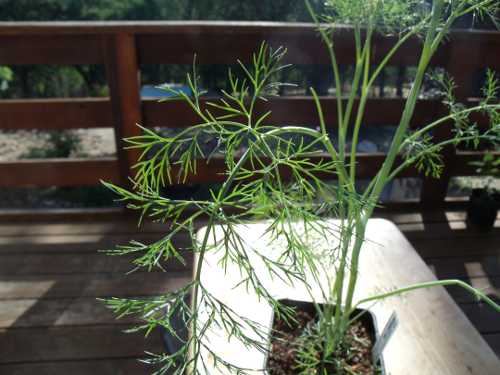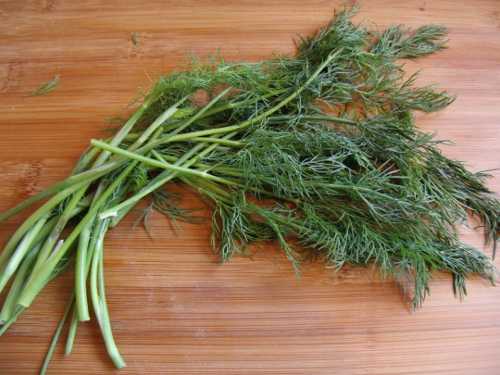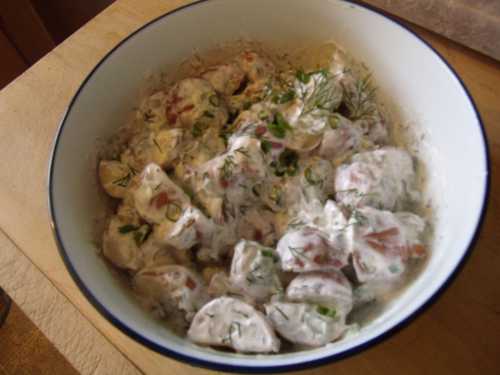
A backyard herb garden is slowly taking shape at my home.
Throughout the last month, a variety of fragrant starts have found their way into terra cotta dwellings on my deck or patio. Little by little, the garden – such as it is – is growing, both in height and breadth.
Its latest addition is a healthy little dill plant, though “little” is a relative term. Compared to the young starts of other herbs such as basil, mint or thyme, it’s fairly tall, with feathery-leaved arms waving in the breeze, looking loftily down on its shorter herbal brethren.
Some dill plants grow to an impressive height of more than five feet; however, three feet or so is a more typical size. Dill attracts bees to the garden and is often used as a magnet for beneficial insects in companion plantings with vegetables.
Dill, hearty and resilient, is known for reseeding and spreading throughout a garden.
Dill flowers are umbels, meaning many stalks emanate from a common stem, each with a flower at its tip. Together they form a large, round, flat-topped yellow bloom about six inches across.
Dill’s feathery foliage may be harvested beginning in spring and throughout the summer. The blooming season for dill is generally from July through September, and seeds are harvested when the flowers mature.
With both the foliage and seeds used in cuisine, dill leaves are sometimes called “dill weed” to differentiate it from the seeds of the plant.
Dill is native to southern Russia, western Asian (India, for example) and the Mediterranean region of southern Europe and North Africa. It’s popular as a seasoning in the cuisines of these regions, in addition to northern and central Europe (think Scandinavia and Germany), the Middle East (particularly Iran) and Southeast Asia (specifically Laos, though parts of northern Thailand and areas of Vietnam utilize it).
In Southeast Asia, dill is known in English as Laotian coriander, and is typically used with seafood in that country, such as with fish steamed in banana leaves or in seafood curries.
Similarly, in Scandinavia, dill is used to flavor gravlax, a cured salmon dish. Dill, along with salt, sugar and coarse black pepper, coat the fish as it’s curing, a process that’s done over a few days in the fridge while the salmon is wrapped and weighted. Thin slices of gravlax make a slightly sweet and salty appetizer, often paired with hearty rye bread, mustard and cucumber.
Dill, both the leaves and seeds, are used as pickling spices. Dill pickles made from cucumbers preserved in brine and dill are enjoyed throughout Europe and North America; however, dill is also used as a pickling spice in Arabic countries, where the term for dill translates as “cricket eye.”
The root of the English word for dill is not quite as colorful, though it has a practical meaning. It comes from the Norse word “dilla,” which means “to lull,” appropriate because of its calming effect on the muscles, particularly those of the digestive tract. It’s been used for centuries in teas and other remedies as a curative for digestive problems.

In India, dill is used in “mukhwas,” an after-meal digestive aid, and in medieval Europe, Charlemagne is said to have made dill seeds available on his banquet tables as a carminative (an anti-flatulence agent) for his guests. Gripe water, a remedy for colicky babies, has dill seed as an ingredient.
The ancient Greeks considered dill a sign of wealth, even burning the oil to display status.
Hippocrates, a physician in that society, recommended dill for cleaning the mouth. His recipe reads more like an after dinner drink than a cleanser, however: “Clean teeth with a ball of wool dipped in honey and rinse with 1 teaspoon of dill seed boiled in 1/2 cup of white wine.”
Whenever possible, use fresh dill leaves, rather than dried, as the flavor and fragrance of the fresh, feathery fronds are superior. Because the flavor of fresh dill breaks down in cooking, add it at the last minute. It is recommended that dill be snipped with scissors, rather than chopped with a knife, to preserve its delicate flavor.
Fresh dill should be stored in the fridge, either with its stems placed in water or wrapped in a damp paper towel. Dill can be frozen, either whole or chopped, in an airtight container. Some people keep whole dill fronds in zipper locked bags in the freezer, pulling them out to snip off just enough dill for a recipe and then returning them to the freezer.
Dried dill seeds will stay fresh for about six months if kept in an airtight container (preferably glass) in a cool, dry, dark place.
Both the seeds and leaves contain calcium, iron and manganese; in fact, a tablespoon of dill seeds contains as much calcium as one-third of a cup of milk. Dill is considered a good source of fiber.
Dill has anti-bacterial properties due to the volatile oil present in the plant. As well, the activity of its volatile oils qualify it as a “chemoprotective” food (much like parsley) that can help neutralize particular types of carcinogens, such as smoke from charcoal grills, cigarettes and the like.
In addition to pickling, dill seeds are used to flavor breads, like the caraway seeds to which they’re often compared. The seeds have a stronger flavor than the leaves.
Fresh dill leaves make a wonderful sauce for fish or asparagus when combined with mayonnaise, yogurt or sour cream and flavored with fresh lemon juice.
Dill is a main flavor component of beet borscht, Russia’s signature soup and a favorite in Eastern European countries. I especially love borscht served hot with a dollop of thick Greek yogurt or sour cream and freshly-snipped dill.
Fresh dill adds brightness to scrambled eggs, omelets, egg salads and stuffed eggs. I like using it in sandwiches, such as with tuna or fresh garden tomatoes.
Cucumbers and dill are made for each other, as are dill and tomatoes. When these companionable vegetables are pulled from summer gardens, make a salad, simply dressed with olive oil, a splash of red wine vinegar and fresh dill.
Combining cucumber, yogurt and fresh dill makes for a cooling summer salad. When the cucumber is diced finely, an Indian- or Greek-inspired dip or sauce is created.
You may be wondering why I didn’t mention dill and potatoes, another classic combo, especially in cold potato salads. Perhaps you could say I saved the best for last.
I made a red potato salad with dill this evening for dinner, and I made note of the proportions of each component so I could fashion it into a recipe for you. My version of this classic salad, simple yet tasty, is below. Enjoy!
Dilled red potato salad
2 pounds or more small red potatoes
3-4 scallions, white and green parts thinly sliced
Approximately ¼ cup snipped fresh dill (or less to taste)
½ cup sour cream
½ cup mayonnaise
1 tablespoon white wine vinegar
Salt and pepper to taste
Wash potatoes and remove eyes. (Do not peel.) Cut them into bite sized pieces and cook until just tender in salted, boiling water. Drain and plunge into ice water bath to stop cooking process.
Combine sour cream, mayonnaise, vinegar, dill and scallions and blend well. Adjust seasonings, adding salt and pepper to taste.
Drain potatoes and put in a serving bowl. Pour sour cream dressing over them, gently folding potatoes into dressing to coat all pieces well.
Makes six to eight servings.
Recipe by Esther Oertel.
Esther Oertel, the “Veggie Girl,” is a culinary coach and educator and is passionate about local produce. Oertel teaches culinary classes at Chic Le Chef in Hidden Valley Lake, Calif., and The Kitchen Gallery in Lakeport, Calif., and gives private cooking lessons. She welcomes your questions and comments; e-mail her at This email address is being protected from spambots. You need JavaScript enabled to view it..
Follow Lake County News on Twitter at http://twitter.com/LakeCoNews , on Facebook at http://www.facebook.com/pages/Lake-County-News/143156775604?ref=mf , on Tumblr at http://lakeconews.tumblr.com/ and on YouTube at http://www.youtube.com/user/LakeCoNews .


 How to resolve AdBlock issue?
How to resolve AdBlock issue? 





